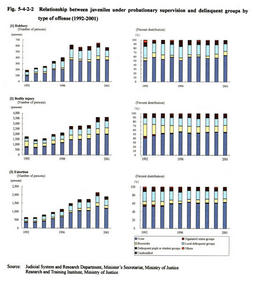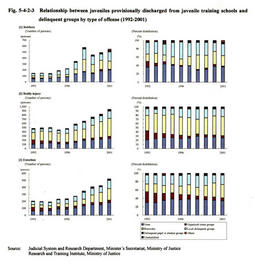| Previous Next Index Image Index Year Selection | |
|
|
2 Trends in relationship between juveniles and delinquent groups Fig. 5-4-2-2 shows the trends in the relationship between juveniles placed under probationary supervision and delinquent groups for robbery, bodily injury, and extortion (the number of persons newly received for these 3 offenses was higher than other offenses in 2001). Likewise, Fig. 5-4-2-3 shows the trends in relationship between juveniles provisionally discharged from juvenile training schools and delinquent groups for these 3 offenses. Comparing Fig. 5-4-2-2 and Fig. 5-4-2-3 , it can be pointed out that, for almost all types of offense, the rate of juveniles provisionally discharged from juvenile training schools who have a connection with delinquent groups is higher than that of juveniles placed under probationary supervision who have a connection with such groups.
Viewing the trends of juveniles placed under probationary supervision from the standpoint of the percent distribution of such juveniles, the rate of bosozoku (motorcycle gangs that cause disturbances and acts of violence, etc.) has decreased for bodily injury and extortion, and overall, the rate of delinquent group members has been on a decreasing trend. However, the number of delinquent group members has increased for each offense, which is worthy of attention. On the other hand, concerning the trends of juveniles provisionally discharged from juvenile training schools, the rate of bosozoku is high for bodily injury, though continuing to increase and decrease. According to this information, it can be presumed that offenses of this kind have a close connection with bosozoku and persons of violent nature are likely to participate in motorcycle gangs. As for extortion, which shows an unusual trend, it is notable that the percent distribution has fallen off for organized crime group members and has increased for bosozoku instead. Overall, though the juveniles placed under probationary supervision who had no connection with delinquent groups have increased in terms of both number and percent distribution, it does not mean that the number of delinquent group members has decreased. Rather, it seems to have increased the necessity to establish special measures for the treatment of juveniles under probationary supervision who in the past had a connection with delinquent groups such as bosozoku. Furthermore, concerning the decrease in the rate of organized crime group members to the total persons under probationary supervision, there is a possibility that problems of organized crime groups exist behind those of bosozoku on the grounds that some organized crime groups have various impacts on the activities of bosozoku in the community. Therefore, we should be cautious about future trends in organized crime group members from the viewpoint of the treatment for probationary supervision. Fig. 5-4-2-2 Relationship between juveniles under probationary supervision and delinquent groups by type of offense (1992-2001) Fig. 5-4-2-3 Relationship between juveniles provisionally discharged from juvenile training schools and delinquent groups by type of offense (1992-2001) |

